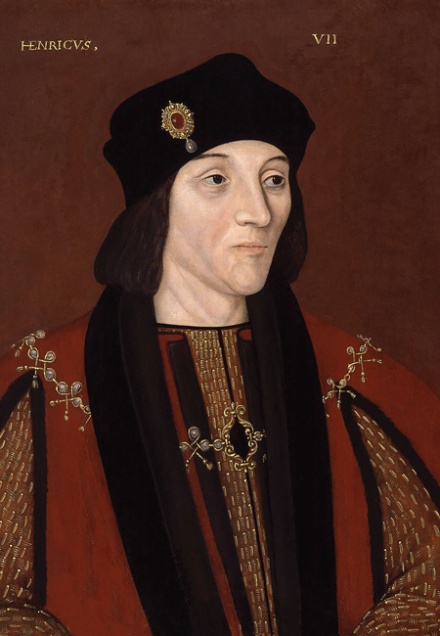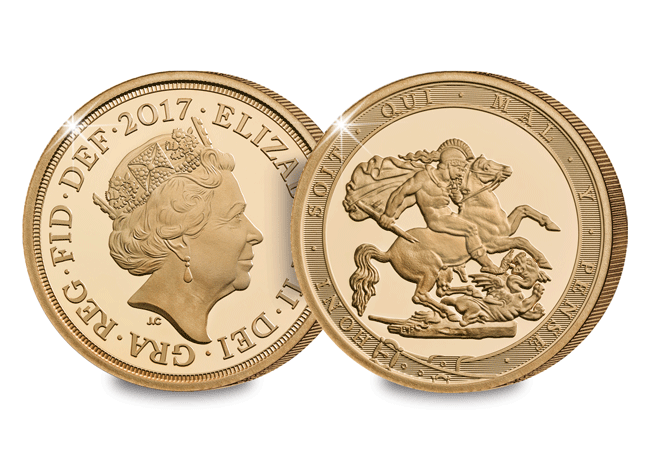Posts Tagged ‘benedetto pistrucci’
Introducing 200 years of the Sovereign. Part I: Back to the very beginning…
2017 marks the Bicentenary of the Modern Sovereign. Reinstated as part of the 1816 Great Recoinage to replace the Guinea, the ‘modern’ Gold Sovereign has epitomised British quality across the world for the last 200 years.
But there is much more to discover about the Gold Sovereign. And now, in the lead up to its special anniversary, we explore its story in a six part series of posts about its 200 years of fascinating history, telling the tale of the King of Coins from its very beginning in 1489 to now.
First, back to the very beginning…
The history of the Sovereign dates back as far as 1489, when King Henry VII instructed The Royal Mint to strike a new gold coin.
The new coin weighed twice as much as the existing Ryal and it was the first coin to be issued with a value of one pound sterling. It was struck in almost pure gold using the standard gold coinage alloy of 23 carat.
A Design with International Power
The coin was fittingly called the Sovereign, which was also the name of his warship that had been built the year before. Its design was inspired by a coin issued in the Netherlands by Emperor Maximilian in 1487 and featured King Henry on his throne, with orb and sceptre in his hands radiating the power of the monarchy.
The Latin inscription on the coin read ‘Henry, by the Grace of God, King of England and France, Lord of Ireland’, which sent a message to Europe that England was a nation to be reckoned with. The reverse design featured a shield bearing the Royal Arms on a large Tudor Rose.
The Sovereign became the flagship coin of the Tudor reign and was struck in turn by each Tudor monarch and is still considered the flagship coin of the Royal Mint today.
The Forgotten Years
However, the production of the Sovereign stopped when King James I inherited the throne and introduced a new pound coin, the Unite (named to mark his desire to unite England and Scotland).
And the Sovereign was forgotten for nearly 213 years, until 1816, when something momentous in the history of British coinage was to happen…
Find out what happened in Part II of our 200 years of the Sovereign Blog Series – click here to read it >>
Announcing the new UK Bicentenary Gold Proof Sovereign
To mark the Bicentenary of the “modern” Gold Sovereign in 2017, The Royal Mint have just released a brand new Gold Proof Sovereign reprising Benedetto Pistrucci’s original engraving from 1817.
With a low edition limit of just 10,500 worldwide, a special one-year-only design change and a fine proof finish, the 2017 Bicentenary Gold Sovereign has all the elements to be one of the most collectable British gold coins of the 21st century. And now you can own one.
Click here to secure yours today >>
The medal 30 years in the making…
With the Battle of Waterloo reaching its 200th Anniversary this year, I have come across some fascinating commemoratives which have been issued to mark the historic event. However, there was one in particular that really caught my eye and has an intriguing story behind it…
It all started in 1815 when The Royal Mint was commissioned by the Duke of Wellington to strike a medal honouring the leaders of the allied nations following the Battle of Waterloo.
The medal was to be of the grandest scale, finished with outstanding detail – a task perfectly suited to Royal Mint Chief Medalist Bendetto Pistrucci – whose proposed design was chosen from a shortlist.
Pistrucci was a masterful engraver with a mercurial personality. He had already completed a stunning design of St George and the Dragon (which famously still graces the Sovereign today). His design for the medal looked set to be one of the greatest ever undertaken…
But, there was a problem
Pistrucci was under the impression that Master of the Mint, William Wellsley-Pole, had promised him the position of Chief Engraver at the Royal Mint. However, as a result of politics and infighting at the Mint, it became apparent his ambitions would never be fulfilled.
In fact he soon recognised that once he had completed the Waterloo medal, The Royal Mint was sure to cut all ties with him. Determined not to let this happen, Pistrucci took his time, and prolonged the project – by 30 years.
By the time the dies were completed, all the intended recipients were dead, except for Wellington himself.
The end result was one of the most magnificent pieces of medallic art ever seen, but this wasn’t the end of the story. Pistrucci’s dies were so large and complicated that they proved impossible to harden and the medal that had taken three decades to complete was never even struck.
So the ill-fated Waterloo medal remains one of the most fascinating chapters in the history of The Royal Mint, and is still talked about to this day – despite the fact it never even made it to production!
Now the medal has been made…
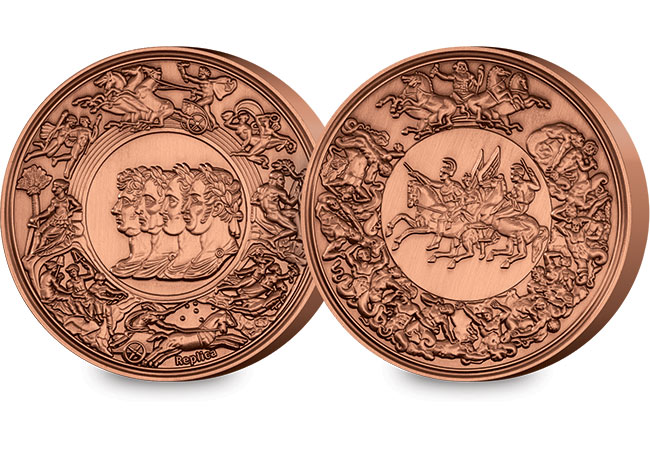
Using the latest minting technology, a small batch of just 495 replica medals have been made for the anniversary year of The Battle of Waterloo. We still have some available if you’re interested, click here for details.
The Making of a British Icon
How an Italian engraver produced the most British coin of all time
Across the world, one coin is seen to epitomise all that it is British in a way that compares with nothing else. That coin is the Gold Sovereign. And at the centre of its international reputation is a quintessentially British design – St. George slaying the dragon.
Yet it is not, as you may first think, the work of a classical British artist, but instead that of the second son of an Italian federal court judge, who only came to England just two years before his portrayal of St. George and the Dragon first adorned a British coin in 1817.
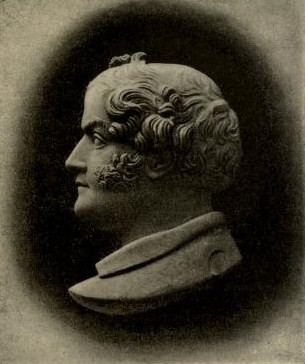
Cameo of Benedetto Pistrucci, by his daughter c. 1850
In fact well before his arrival in England in 1815, Pistrucci was already well established as a leading gem engraver and producer of fine cameos amongst European high society. He rapidly made an impression on his arrival in London, winning the approval of the well-known antiquarian William Richard Hamilton.
Despite having no coin or medal experience, he was quickly commissioned by the Master of the Mint Wellesley Pole, brother of the Duke of Wellington, to produce a new portrait of George III as part of the Great Recoinage. His model, created in the unusual medium of red jasper, was re-engraved by Thomas Wyon for its final use on coinage losing, in Pistrucci’s eyes at least, much of the detail.
However, his work was clearly of sufficient quality to impress Pole, who followed up with a commission for the design that has forever since been the synonymous with the name Benedetto Pistrucci – St. George and the Dragon.
A design nearly lost the annals of history
Yet within just eight years it looked like Pistrucci’s design might disappear forever, as the Royal Mint changed the Sovereign reverse design to an heraldic shield, which was to remain in place for the next 46 years.
It was only a drive to improve the design quality of the coinage, led by new Deputy Master, Charles Fremantle that saw the re-introduction of St. George in 1871. However, both reverse designs were struck concurrently until 1887 when the Chancellor of the Exchequer declared that “by tradition and recommended by the great beauty of the design” Pistrucci’s design should once again appear on all Gold Sovereigns.
“The chief coin of the world”
By the mid-1850s the “new” Gold Sovereign had become a coin of true international status. Indeed an official list identifies no fewer than thirty-six colonies and dependencies in which the gold sovereign or half sovereign was recognised as legal tender.
More surprisingly, so great had become the reputation of the British sovereign that it was also in regular use in other countries outside the Empire, including Brazil, Egypt and Portugal.
However, it was the opening of the Sydney branch of the Royal Mint in 1855 following the discovery of gold in Australia that really marked the international growth of the Sovereign. Initially authorised to strike Sovereign’s to a different design, in 1871 Sydney finally started to strike coins of the same designs as the UK (just in time for the Pistrucci revival), only identified by a small “S” mintmark.
Further Australian Royal Mint branches followed in Melbourne in 1871 and Perth in 1899, before the Mint’s reach extended to other Empire countries with branches opening in Ottowa (1899), Bombay (1918) and Pretoria (1923) – all producing Gold Sovereigns.
It is no wonder that the eminent economist of the early 20th Century, Sir John Clapham, proclaimed the Gold sovereign as “the chief coin of the world”.
A worldwide modern icon – good enough for 007
The last international sovereign was struck in Pretoria in 1932. By then the international interest in Gold Sovereign, which started in Victorian times was well and truly established. And it is a reputation that continues right up to today.
Ian Fleming chose to equip James Bond with 50 Gold Sovereigns in his attaché case in the From Russia with Love, whilst Special Forces are still believed to carry Gold Sovereigns, as an emergency international currency.
In 2012 the Royal Mint once again authorised the striking of the St. George and the Dragon Gold Sovereign outside the UK under licence in India, so great is its popularity amongst the people there.
Reference
“The Royal Sovereign 1489 – 1989”, Ed GP Dyer
“A New History of the Royal Mint”, Christopher Edgar Challis
The Royal Mint Museum Website
________________________________________________________________
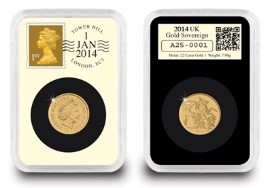
The 2014 Gold Sovereign is available in a limited edition DateStamp™ Presentation of just 995 pieces –now sold out.


